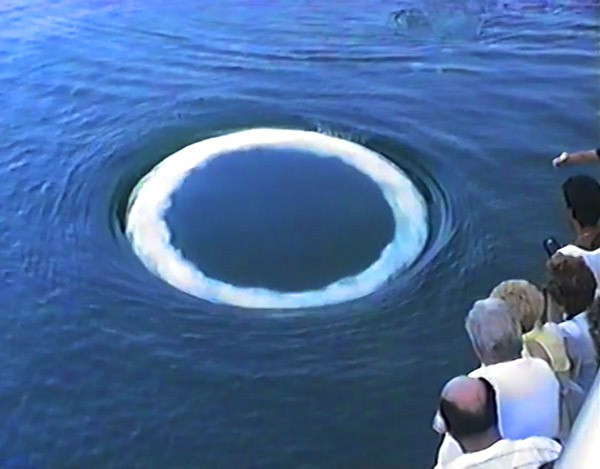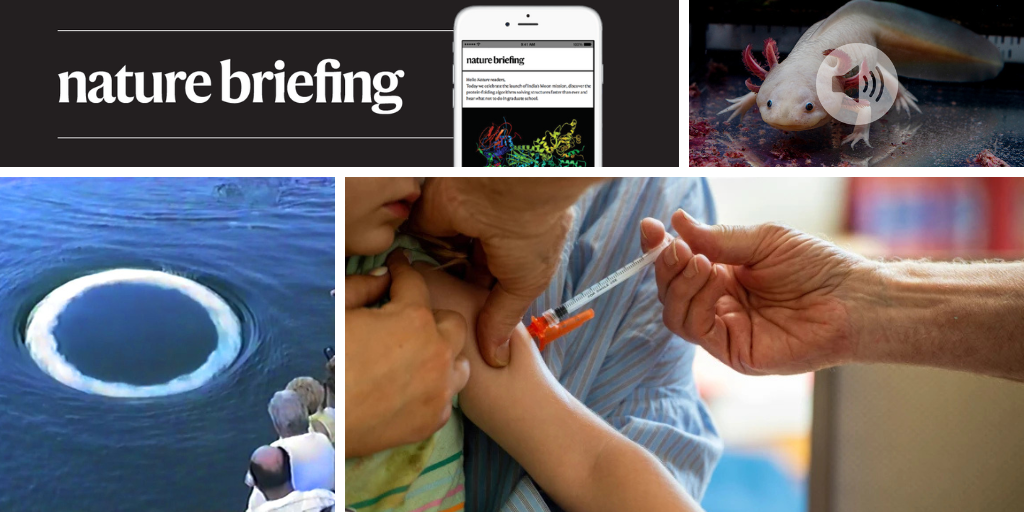You have full access to this article via your institution.
Hello Nature readers, would you like to get this Briefing in your inbox free every day? Sign up here.

This bubble ring was captured on video in 1988 in the Stellwagen Bank National Marine Sanctuary in Massachusetts. (© Dan Knaub, The Video Company)
Scientists exploring how we might speak to extraterrestrials say that humpback whales (Megaptera novaeangliae) might be signalling to us with bubbles. WhaleSETI researchers found 12 examples of whales creating bubble rings near people, but none in various multi-year studies that observed whales remotely using drones. “We’ve now located a dozen whales from populations around the world, the majority of which have voluntarily approached boats and swimmers blowing bubble rings,” said marine wildlife photographer and study co-author Jodi Frediani in a statement.
Reference: Marine Mammal Science paper
A person’s breathing pattern might be as unique to them as their fingerprint, and could even be used to identify them. Using a wearable device, researchers tracked the breathing of 97 people over 24 hours, and trained a machine-learning algorithm on the data. After a second measurement, the algorithm could identify people from their breath patterns with 96.8% accuracy. There was also some correlation between a person’s breathing patterns and factors such as their body-mass index and levels of anxiety. “In a way, we’re reading the mind through the nose,” says neurobiologist and study co-author Noam Sobel.
Reference: Current Biology paper
On Monday, US Health Secretary Robert F. Kennedy Jr — who has promoted vaccine misinformation and public-health conspiracies — abruptly fired all the members of a prominent vaccine-advisory panel at the US Centers for Disease Control and Prevention (CDC), citing undefined conflicts of interest. On Wednesday, he named a new cohort — leapfrogging the typical vetting process, which is led by CDC staff members and can take years. A number of the new panel members move in vaccine-sceptic circles; one serves on the board of an anti-vaccination organization, and a second has been a prominent sceptic of the COVID-19 vaccines on social media.
Read more: With doubts about vaccine safety on the rise worldwide, vaccine and public-health experts share their evidence-based tips for talking about vaccines with your inner circle. (Nature | 10 min read)
Features & opinion

Physicist Werner Heisenberg is said to have made his breakthrough in quantum mechanics while visiting the island of Heligoland in 1925.Credit: Günter Gräfenhain/mauritius images via Alamy
“Heligoland’s stark red cliffs and stiff breeze makes it a perfect place to roam, contemplate and hope that some of Heisenberg’s genius rubs off,” writes Nature reporter Elizabeth Gibney. She’s been attending “the physics event of the year” on the North Sea island where Werner Heisenberg formulated the mathematics behind quantum physics in 1925. As hundreds of physicists descend on the island, they are reflecting and expanding on quantum theory’s many outstanding questions.
In a laboratory in England, scientists are painstakingly creating genetically modified mosquitoes, one by one. “If you’re too rough, the eggs explode,” says a technician of the process of injecting a tiny genetic construct into each egg with a microscopic glass needle. The insects will be shipped to Djibouti, where they are part of a high-stakes fight against the rise of malaria in cities, driven by a different mosquito species than the one that scientists have been grappling with for decades in the countryside. “We knew what we were dealing with — until we didn’t,” says Djibouti health advisor Abdoulilah Ahmed Abdi. “Then came Anopheles stephensi, and everything we thought we knew about malaria control was thrown into chaos.”
A pair of lovers navigate very different experiences of their shared world in the latest short story for Nature’s Futures series.
Researchers have developed a soft electronic implant that can measure the brain activity of amphibian embryos as they develop. “The brain is very soft, like a piece of tofu, and traditional electronics are very rigid,” says bioelectronics researcher Jia Liu. As such, conventional probes can damage the brain and trigger an immune response, which interferes with the readings it takes. To get better insight into a developing brain, Liu and his team have developed a flexible mesh that stretches with the brain as it grows, and tested it on developing frog and axolotl embryos.
Nature Podcast | 36 min listen
Subscribe to the Nature Podcast on Apple Podcasts, Spotify or YouTube Music, or use the RSS feed.
Today Leif Penguinson is hiking in Haute-Fillière State Forest in France. Can you find the penguin?
The answer will be in Monday’s e-mail, all thanks to Briefing photo editor and penguin wrangler Tom Houghton.
If you enjoy this newsletter, I’d be very grateful if you were to recommend it to a friend or colleague. Please click here to forward it by e-mail. Thank you!
Thanks for reading,
Flora Graham, senior editor, Nature Briefing
With contributions by Jacob Smith
• Nature Briefing: Careers — insights, advice and award-winning journalism to help you optimize your working life
• Nature Briefing: Microbiology — the most abundant living entities on our planet — microorganisms — and the role they play in health, the environment and food systems
• Nature Briefing: Anthropocene — climate change, biodiversity, sustainability and geoengineering
• Nature Briefing: AI & Robotics — 100% written by humans, of course
• Nature Briefing: Cancer — a weekly newsletter written with cancer researchers in mind
• Nature Briefing: Translational Research — covers biotechnology, drug discovery and pharma


